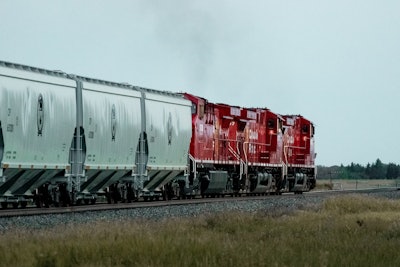
Trade challenges are permeating nearly every industry, and feed production is no different. A combination of regional dynamics, regulatory pressures and structural changes are shaping a complex market, seemingly shifting by the day. Tariff proposals continue to cause market dynamics to fluctuate — recently, markets saw soybean prices plummet from $10.33 per bushel on April 1 to $9.77 by April 4, and then increase back to $10.44 by April 11.
As David Quigley, marketing director of EverAg explained, feed mills are finding increased pressure to do more with fewer resources — there’s less time at their disposal, fewer drivers and employees to manage the positions and tighter delivery windows. In an uncertain market, feed production professionals must be equipped with the tools to secure their supply chain and effectively navigate economic shifts.
This article will explore how advanced logistics and transportation management tools are addressing supply chain challenges in feed production and how feed mills can integrate these tools to mitigate challenges in a turbulent market.
Distribution in a shifting landscape
Several converging trends are increasing complexity among feed logistics: consolidation of producers and suppliers, regulatory demands, production models that require near-perfect delivery timing and customer expectations to operate with transparency, quickly and efficiently.
When feed mills are busy trying to maintain day-to-day operations, it is nearly impossible to focus on proactively enhancing their production.
“As the entire feed supply chain becomes more data- and service-driven, the old ways of managing logistics — spreadsheets, whiteboards or phone calls — just can’t keep up,” Quigley said.
For the agricultural shipper, there are several factors at play determining the most effective way to streamline their logistics. Ample data allows these professionals to gain full visibility into their transportation system, though they must utilize the data effectively to garner predicted trends and valuable insights.
“For example, if a railroad issues a bad order and pulls a car out of service, shippers will likely need to reroute other products to meet customer delivery deadlines,” said Andy Adams, senior solutions engineer, TransmetriQ.
Immediate awareness of disruptions must be found early to address the downstream impacts on those involved.
Put plainly, tracking the activity of feed shipments is only useful if operators can draw trends behind the activity. And still, today’s market does not make it easy for a shipper to be proactive, let alone leverage the data and expertise to glean actionable insights. Immediate awareness of disruptions is helpful, but identifying scenarios and planning ahead remains a challenge.
Navigating supply chain volatility, whether caused by tariffs or other factors, remains a critical component in enhancing feed mill production. Therefore, agribusinesses must leverage the tools at their disposal to address these challenges — one way is by using a transportation management system (TMS).
What is a TMS?
A TMS is a logistics platform that uses technology to help businesses plan, execute and optimize the physical movement of goods, both incoming and outgoing, and making sure the shipment is compliant. In a feed mill setting, a TMS allows operators to gain a full glimpse into feed mill logistics, facilitating accurate monitoring and transparent communication. Operators can use a TMS to reduce costs, solve inefficiencies, plan ahead and effectively relay updates to customers.
“In addition to improving internal fleet efficiency, a strong TMS gives fleet operators easy access to a larger network of third-party carriers,” said David Figueroa, commercial director of Greenstone Systems. “By reducing their reliance on owned assets, operators can improve operational agility and save money on labor, insurance and truck maintenance.”
In today’s age, there is ample data available to feed mill logistics operators — at a moment’s notice, they can know if there are delays, a railcar is loaded or empty, if there are other products in the area to meet customer delivery requirements, and so on.
TMS systems can help feed mill operators:
- Make more informed decisions to improve agility. A strong TMS gives operators easy access to a larger network of third-party carriers, which ultimately helps save money on labor, maintenance, insurance and more.
- Provide real time visibility to freight movement. Through GPS tracking and telematics, a TMS provides significantly more accurate depiction of the supply chain progress, allowing the feed production team to more accurately monitor movement and proactively communicate updates with the customer.
- Promote better service level performance. With a more accurate read on the progress of shipments, the TMS increases transparency and stakeholder trust with precise tracking and effective communication of shipment updates.
- Optimize output with limited resources. TMS tools can improve route efficiencies and delivery consolidation, ultimately reducing the number of trips required for a more cost effective, sustainable business model.
“While monitoring and reporting can be done with event data alone, having a transportation management platform that automatically alerts shippers to action-needed scenarios and that generates reports instantly can save shippers hours,” said Adams.
Future proofing transportation and supply chains
As TMS systems allow feed mill operators to be more proactive, these systems will become a foundational strategy for elevating operations and staying ahead of industry challenges. With the continued rise in automation, artificial intelligence and sustainability regulations, it will be crucial for feed mill operators and logistics companies to ensure their transportation management is positioned for strong supply chains.
As more agricultural shippers integrate TMS systems into practice, they can anticipate improved predictive capabilities, like AI providing intelligent route optimization, origin-to-destination analytics and real-time visibility into transport operations, Figueroa said. These improvements will ultimately help build resilience in the face of any new economic or logistics challenges.
The development of telematics, or the integration of telecommunications and informatics to collect and transmit data from vehicles or equipment, will also play a key role in planning for the future of feed mill logistics.
With the ability to track vehicle performance, hopper conditions and bin levels, operators will be able to make more intelligent and responsive decisions, leveraging data as the key indicator of resource usage and projected growth.
“In the future, we can expect to see more research being done on automation and robotics in mill operations, especially in the areas of autonomous loading and unloading,” Figueroa also noted. “These technologies could reduce operational bottlenecks by streamlining labor-intensive, high-touch processes.”
Even amid uncertain planning, knowledge can provide power in a volatile supply chain environment. The more insights available, the better prepared feed mill operators will be to identify gaps and inefficiencies in their processes and take proactive measures. Scaling and integrating a TMS system is one key step to a more resilient future.

















